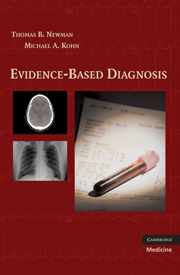Book contents
- Frontmatter
- Contents
- Preface
- Acknowledgments & Dedication
- Abbreviations/Acronyms
- 1 Introduction: understanding diagnosis and diagnostic testing
- 2 Reliability and measurement error
- 3 Dichotomous tests
- 4 Multilevel and continuous tests
- 5 Critical appraisal of studies of diagnostic tests
- 6 Screening tests
- 7 Prognostic tests and studies
- 8 Multiple tests and multivariable decision rules
- 9 Quantifying treatment effects using randomized trials
- 10 Alternatives to randomized trials for estimating treatment effects
- 11 Understanding P-values and confidence intervals
- 12 Challenges for evidence-based diagnosis
- Answers to problems
- Index
- References
2 - Reliability and measurement error
Published online by Cambridge University Press: 04 August 2010
- Frontmatter
- Contents
- Preface
- Acknowledgments & Dedication
- Abbreviations/Acronyms
- 1 Introduction: understanding diagnosis and diagnostic testing
- 2 Reliability and measurement error
- 3 Dichotomous tests
- 4 Multilevel and continuous tests
- 5 Critical appraisal of studies of diagnostic tests
- 6 Screening tests
- 7 Prognostic tests and studies
- 8 Multiple tests and multivariable decision rules
- 9 Quantifying treatment effects using randomized trials
- 10 Alternatives to randomized trials for estimating treatment effects
- 11 Understanding P-values and confidence intervals
- 12 Challenges for evidence-based diagnosis
- Answers to problems
- Index
- References
Summary
Introduction
A test cannot be useful unless it gives the same or similar results when administered repeatedly to the same individual within a time period too short for real biological changes to take place. Consistency must be maintained whether the test is repeated by the same measurer or by different measurers. This desirable characteristic of a test is generally called “reliability,” although some authors prefer “reproducibility.” In this chapter, we will look at several different ways to quantify reliability of a test. Measures of reliability depend on whether the test is being administered repeatedly by the same observer, or by different people or different methods, as well as what type of variable is being measured. Intra-rater reliability compares results when the test is administered repeatedly by the same observer, and inter-rater reliability compares the results when measurements are made by different observers. Standard deviation and coefficient of variation are used to determine reliability between multiple measurements of a continuous variable in the same individual. These differences can be random or systematic. We usually assume that differences between repeated measurements by the same observer and method are purely random, whereas differences between measurements by different observers or by different methods can be both random and systematic. The term “bias” refers to systematic differences, distinguishing them from “random error.” The Bland–Altman plot describes reliability in method comparison, in which one measurement method (often established, but invasive, harmful, or expensive) is compared with another method (often newer, easier, or cheaper).
- Type
- Chapter
- Information
- Evidence-Based Diagnosis , pp. 10 - 38Publisher: Cambridge University PressPrint publication year: 2009
References
- 2
- Cited by



